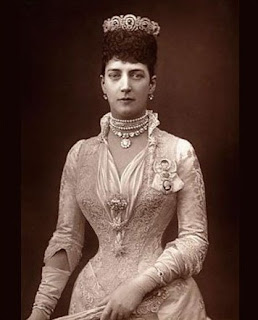The prevalence of choker pieces of jewellery is at an
untouched high right now, with in vogue stars like Taylor Swift and Kendall
Jenner, alongside some our most loved bloggers, finishing off their coolest
looks with the adornment. Once considered a styling touch reminiscent of the
'90s, the champion piece has been changed into something totally cutting edge,
with such a large number of versions on offer that ladies of each style
influence are giving it a shot. Inquisitive as to where these well known pieces
of jewellery initially started, we did a touch of burrowing and found that they
go much further back than we envisioned.
As per master custodians from the Jewellery Museum of Fine
Arts in Boston, chokers have been around for a huge number of years, first
gracing the world's soonest human advancements: the Sumer Empire in Mesopotamia
and Ancient Egypt. Regularly done up in gold or lapis, the pieces of jewellery
were thought to be defensive and permeated with uncommon forces.
 |
| Princess Alexandra of Denmark |
Chokers rose again all through the Renaissance as simply
complex decisions and were particularly famous with royals towards the end of
the nineteenth century. Amid this last period, ladies in Germany and Austria
additionally utilized the pieces of jewellery to conceal irregularities on
their necks brought on by goiter, an ailment basic over the Alps at the time.
In different corners of the world, more straightforward strip chokers were
images of prostitution, as portrayed in Manet's celebrated 1863 painting
"Olympia," however the look lost some of its ignoble affiliations
when received by ballet performers before long.
In spite of the fact that they were never completely out of
design, chokers ruled yet again in the 1920s and into the '30s, loaning
themselves to the darling Art Deco style of the time. Whether rendered in
pearls or velvet strip with a focal decal, they were regularly alluded to as
"canine collars" amid this time. Their pervasiveness blurred once the
1940s started, yet they were embraced by and by, in more beautiful cycles, by
free-energetic '70s flower children.
 |
| Choker in 1880 |
In the '90s, obviously, chokers re-emerged with a blast,
however they were not the better forms of yore. Rather, the period's rocker
chicks and young ladies wore the notorious plastic tattoo chokers or decided
on the negligible yet stark look of a dark lace. Pop stars like Britney Spears
and Christina Aguilera conveyed the adornments into the early aughts, leaning
toward flashier choices in silver and gold.
Quick forward to 2015 and chokers are again taking the
spotlight as far as patterns for this coming spring and summer. Today's chokers
are about a mix of surfaces, examples, materials and hues. Chokers made with
overwhelming chains, metal, stripes, gems and pearls all have their place on
catwalks right now.
It's captivating to figure out how chokers first happened
around 500 years prior and how they have changed throughout the years. Having
stood the trial of time, it's obvious that chokers are a genuine design symbol
– and these realities doubtlessly let us know that chokers will be around for a
long time to come.
To take a leap into the professional world of jewellery designing, Enroll into Solitaire Diamond Institute's online jewellery designing courses Bangalore.





